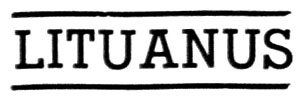
Editor of this issue: L. Sabaliūnas
 |
www.lituanus.org |
|
Copyright
© 1956 Lithuanian
Students Association, Inc.
No..1(6)
- February 1956
Editor of this issue: L. Sabaliūnas |
|
Miscellanea
* * *
One of the salient features of twentieth-century literature is its diversity: numerous distinct schools and movements evolve ~ side by side in the same era and compete for the attention of the same readers. However, the present writers as a rule do not capture the general public. They are too individualistic to appeal to everybody; and, as a consequence, they write for more or less closed groups of devotees. The literature produced by these authors is highly developed and original — opening new vistas of thought and feeling. Modern authors do not have to make too many compromises with the passing fashions and moods, but they win personal freedom to create their art according to their talent and belief.
Hence, it is not extraordinary that we also find good literature produced in languages little known to the world. There is a marked literary activity among Lithuanian immigrants living in the Western World. Lithuanian authors, especially poets, have won their personal freedom at double costs regarding the public. First, they are writing for a small group of Lithuanian immigrants. Second, they have freed themselves from the immigrant's weakness for writing political literature which would exert favorable influence on the world's opinion concerning the liberation of Soviet-occupied Lithuania. This group of Lithuanian writers established, in 1951, a vanguard journal called "Literatūros Lankai" (The Pages of Literature). The aim of the journal is to encourage good literature — avoiding the artificiality, the commonplace, the immigrant's defeatism and servitude to politics and propaganda. The group shares at least one idea with the Existentialists: the principle that life is lived to its fullest only in intense activity — intense literary activity if one chooses to be-"come a writer.
"Literatūros Lankai" is really an outgrowth of a cenacle of highly educated poets, who have a wide background in languages, literary history, and philosophy. In 1951 this group published an anthology of their poetry called "The Earth", the name symbolizing the poets' conscious desires to be Lithuanian authors even when living a-broad. The poets who participated in the anthology were: Kazys Bradūnas (the editor, living in the United States), Juozas Kėkštas (living in Argentina), Vytautas Mačernis (killed during World War II), Henrikas Nagys (living in Canada). Alfonsas Nyka-Niliūnas (living in the United States). The group has been joined by Juozas Girnius, a leading Lithuanian philosopher and a student of Jaspers. In the same year, they also organized "Literatūros Lankai" the chief editor being again Kazys Bradūnas (1127 Bayard Street, Baltimore 23, Maryland). Up to now, 5 issues of the journal have appeared. The group has also been active in presenting Lithuanian literature to foreigners. Just recently, in the Polish journal "Culture", which is published in Paris, there appeared a selection of Lithuanian poetry and some expert literary criticism.
"Literatūros Lankai" is composed of
two parts. There is a section devoted to literature and a section to
literary criticism. Only literature of outstanding merit is published.
The literature section usually consists of the naturalistic and
philosophical poetry by Lithuanian poets, modern Lithuanian drama and
prose, translations of important contemporary literature, etc. In this
section the following
•
Professor Zenonas Ivinskis is president of the Baltic Research
Institute at the University of Bonn, Germany. The institute is
dedicated to the preservation of Lithuanian, Latvian, and Estonian
cultural traditions.
* Samuel Cardinal Stritch, archbishop of Chicago, is honorary
chairman of the building campaign committee which seeks to raise
$250,000 for a new building for DRAUGAS,
the largest free Lithuanian daily in the world. The Cardinal has
commended the newspaper for "effectively combating communism with the
force of the press." DRAUGAS
marks its fortieth anniversary this year.
• Charles J. Kersten, former
U.S. Representative from Wisconsin and at present a Presidential
assistant, was chosen to receive the first Knights of Lithuania award
medal in recognition of his "invaluable service in behalf of
Lithuania's right to freedom." Mr. Kersten was author of House
Resolution 346. which created a select House Committee to investigate
Soviet seizure of the Baltic states and Red atrocities there. After the
resolution's unanimous passage, Mr. Kersten served as the committee's
chairman.
• Professor V. K. Banaitis, now
a resident of Brooklyn, N. Y., has composed an opera based on a
Lithuanian legend. Entitled "Jūratė and Kastytis", it is the story of a
young fisherman who becomes enraptured by a mermaid queen.
• Darius Lapinskas, a young
Lithuanian composer, was a-warded the first prize for his trio for the
piano, oboe, and cello by the Brookline, Mass., library's Music
Society. Judges in the annual contest were Arthur Berger, professor at
Brand-eis University; Dr. Klaus Liep-man, head of the music department
at the Massachusetts Institute of Technology; and Hubert Lamb,
professor at Wel-lesley College.
* *
*
LITERATURE RECOMMENDED
* * *
NO LONGER WITH US
VACLOVAS BIRŽIŠKA, one of the most prominent figures in the Lithuanian academic world, died on January 2nd in Waterbury, Conn.